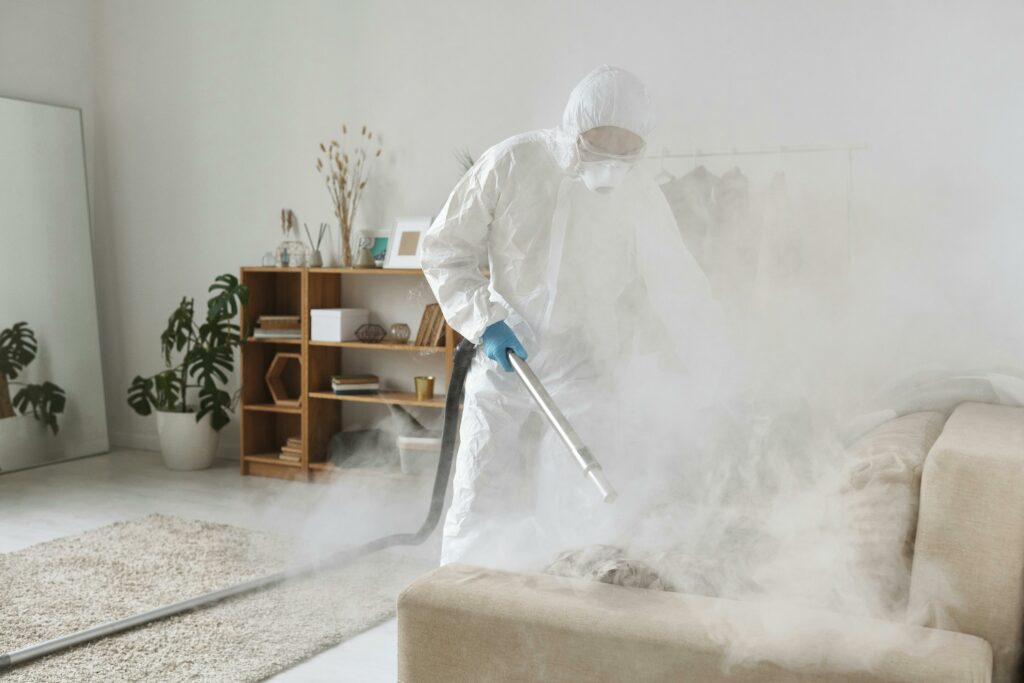A clean and well-maintained sofa is essential for both comfort and health. Sofas are one of the most frequently used pieces of furniture in any home, making them a hotspot for dirt, dust, allergens, and dust mites. Without regular cleaning, sofas can become a breeding ground for bacteria and unwanted pests, affecting indoor air quality and potentially leading to allergies and respiratory issues. Understanding the best cleaning practices and how to prevent dust mites can help keep your sofa fresh, hygienic, and safe for your family.
Key Takeaways
- Regular sofa cleaning removes dirt, allergens, and bacteria, improving indoor air quality.
- Dust mites thrive in fabric and upholstery, feeding on dead skin cells.
- Steam cleaning and vacuuming are effective methods for deep-cleaning sofas.
- Using protective covers and maintaining humidity levels help prevent dust mite infestations.
- Professional sofa cleaning services can enhance hygiene and prolong the life of your furniture.
Why Sofa Cleaning is Essential
Sofas collect a significant amount of dust, sweat, food particles, pet dander, and bacteria over time. The accumulation of these contaminants can lead to unpleasant odors, discoloration, and even health issues. Dust mites, in particular, pose a major problem as they thrive in fabric and upholstery, triggering allergies and respiratory problems.
Health Risks of an Unclean Sofa
An unclean sofa is more than just an eyesore—it can pose significant health risks for you and your family. Over time, sofas accumulate dust, allergens, bacteria, and moisture, creating an environment where harmful microorganisms thrive. The presence of dust mites, mold, and pet dander can trigger allergies, respiratory issues, and skin irritations. In addition, food spills and sweat can contribute to bacterial growth, leading to unpleasant odors and potential health concerns. Regular cleaning and maintenance are essential to ensure a safe and hygienic seating space.
- Allergies and Respiratory Issues: Dust mites, pet dander, and pollen trapped in the fabric can cause sneezing, runny nose, and asthma symptoms.
- Bacterial and Fungal Growth: Spilled liquids and moisture create an ideal environment for bacteria and mold to grow.
- Skin Irritations: Dust mites and bacteria can cause skin rashes, itching, and other dermatological issues.
- Unpleasant Odors: Sweat, food spills, and pet accidents can lead to a foul-smelling sofa.
How Dust Mites Accumulate in Sofas
Dust mites are microscopic organisms that thrive in warm, humid environments and feed on dead skin cells. Sofas provide the perfect breeding ground for them, especially if they are not cleaned regularly. These tiny pests are nearly invisible to the naked eye, but they can multiply rapidly, embedding themselves deep into upholstery and cushions. Without proper maintenance, a single sofa can house thousands of dust mites, contributing to poor indoor air quality and triggering allergic reactions.
Dust mites are microscopic organisms that thrive in warm, humid environments and feed on dead skin cells. Sofas provide the perfect breeding ground for them, especially if they are not cleaned regularly.
Factors That Contribute to Dust Mite Infestations
Several factors make sofas an ideal habitat for dust mites. Understanding these contributors can help you take proactive measures to minimize their presence and maintain a healthier home environment.
- High Humidity: Dust mites thrive in humid conditions, making sofas an ideal habitat. Areas with poor ventilation or high moisture levels encourage mite infestations, as these pests require humidity levels above 50% to survive.
- Lack of Regular Cleaning: Without vacuuming or deep cleaning, dust and skin flakes accumulate, providing food for mites. Over time, the buildup of organic matter allows dust mites to reproduce rapidly, worsening allergy symptoms.
- Fabric Upholstery: Sofas made of fabric tend to trap more dust and allergens compared to leather or synthetic materials. Soft, porous materials like cotton and microfiber absorb moisture and create an ideal environment for mites to flourish.
- Pets and Humans: Pet dander and human skin cells provide a continuous food source for dust mites. Frequent use of the sofa by pets or family members increases shedding, leaving behind dead skin particles that sustain mite populations.

Best Methods for Cleaning Your Sofa
Regular sofa cleaning is necessary to remove dust, dirt, bacteria, and dust mites. Over time, upholstery absorbs sweat, oils, pet dander, and allergens, making it essential to adopt a thorough cleaning regimen. Without regular maintenance, sofas can become a breeding ground for harmful microorganisms, negatively impacting indoor air quality and overall hygiene. Choosing the right cleaning method ensures that your furniture remains fresh, free of dust mites, and comfortable for everyday use. Here are the best methods to keep your sofa clean and allergen-free.
Regular sofa cleaning is necessary to remove dust, dirt, bacteria, and dust mites. Here are the best methods to keep your sofa clean and allergen-free.
1. Vacuuming
- Use a vacuum cleaner with a HEPA filter to remove dust and allergens effectively.
- Focus on crevices, seams, and under the cushions where dust accumulates.
- Vacuum at least twice a week to minimize dust buildup.
2. Steam Cleaning
- Steam cleaning kills dust mites and bacteria using high-temperature steam.
- It is highly effective for deep cleaning and removing stains.
- Professional steam cleaning services can ensure thorough sanitation.
3. Spot Cleaning
- Use a mild detergent or a fabric-safe cleaner to remove stains.
- Blot spills immediately to prevent permanent marks and bacterial growth.
- Avoid soaking the fabric to prevent mold formation.
4. Baking Soda Treatment
- Sprinkle baking soda over the sofa to absorb odors and moisture.
- Let it sit for at least 30 minutes before vacuuming it off.
- This method helps neutralize allergens and keeps the sofa fresh.
5. Professional Cleaning Services
- Experts use advanced cleaning techniques to remove deep-seated dirt and allergens.
- Professional services can extend the lifespan of your sofa.
- Recommended at least once or twice a year for optimal hygiene.
How to Prevent Dust Mites in Your Sofa
Preventing dust mites requires regular maintenance and environmental control. Implementing the following strategies will help keep your sofa free from mites.
1. Maintain Low Humidity Levels
- Use a dehumidifier to keep indoor humidity below 50%.
- Proper ventilation reduces moisture accumulation in upholstery.
- Avoid placing sofas near humid areas like windows or kitchens.
2. Use Protective Covers
- Sofa covers and slipcovers act as barriers against dust and mites.
- Wash covers regularly in hot water to kill mites and bacteria.
- Opt for hypoallergenic covers that reduce allergen buildup.
3. Wash Throw Pillows and Blankets Regularly
- Dust mites can accumulate in pillows and blankets placed on sofas.
- Wash them in hot water weekly to eliminate mites and allergens.
- Use allergen-proof pillowcases for added protection.
4. Sun-Dry Upholstery
- Sun exposure kills dust mites naturally.
- Remove cushions and place them under direct sunlight for a few hours.
- Regular sun-drying prevents the buildup of moisture and mites.
5. Regular Cleaning Routine
- Vacuum and steam clean the sofa regularly.
- Wipe down hard surfaces around the sofa to reduce dust accumulation.
- Keep pets away from the sofa to minimize dander and shedding.
Frequently Asked Questions
1. How often should I clean my sofa to prevent dust mites?
It is recommended to vacuum your sofa at least twice a week and deep clean it every 3-6 months. If you have allergies or pets, more frequent cleaning may be necessary.
2. Can steam cleaning completely eliminate dust mites?
Yes, steam cleaning effectively kills dust mites by exposing them to high temperatures. Regular steam cleaning can significantly reduce mite infestations in upholstery.
3. Are leather sofas better for preventing dust mites?
Yes, leather and synthetic materials do not trap dust and allergens as much as fabric sofas. However, regular wiping and conditioning are still necessary to keep them clean.
4. What is the best way to remove odors from a sofa?
Sprinkling baking soda on the sofa and vacuuming it after 30 minutes helps neutralize odors. Steam cleaning and professional deodorizing treatments are also effective for persistent smells.
Final Thoughts
Keeping your sofa clean and free from dust mites is essential for a healthier home environment. Regular vacuuming, steam cleaning, and using protective covers can significantly reduce allergens and bacteria. By implementing preventive measures such as maintaining low humidity and washing sofa accessories, you can effectively control dust mite infestations. Professional cleaning services provide an added layer of deep sanitation, ensuring your sofa remains fresh, hygienic, and comfortable for years to come.





